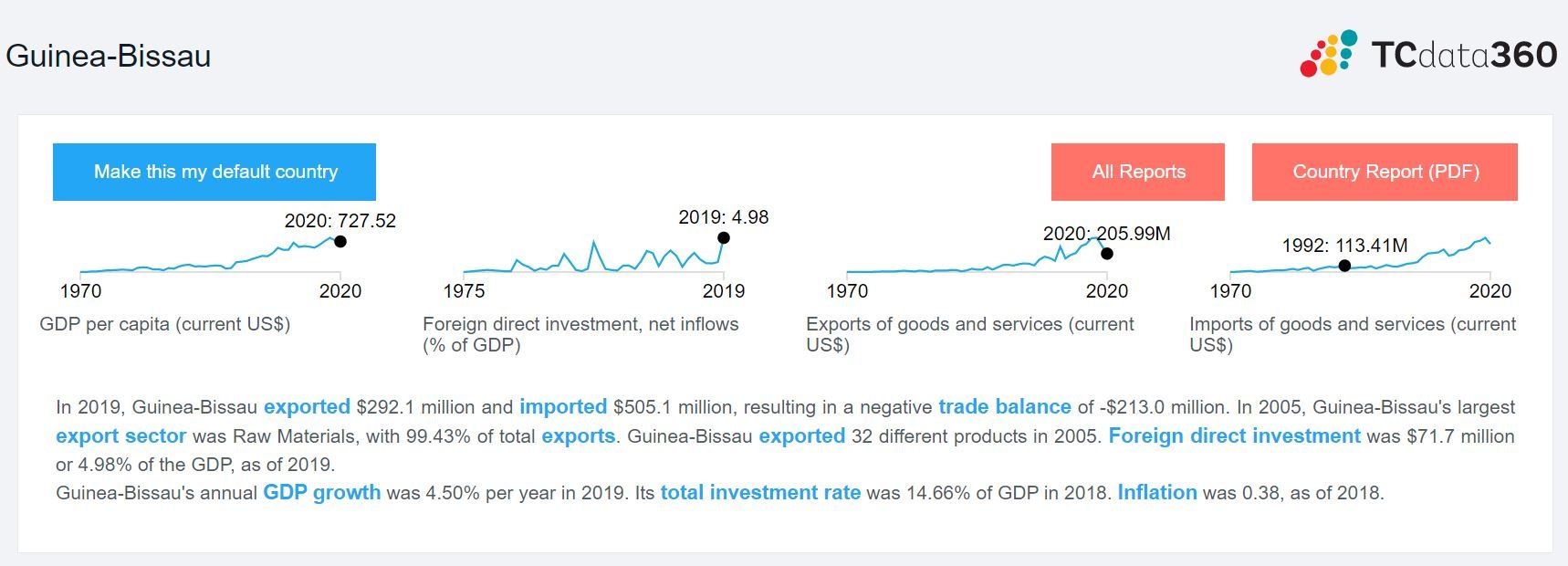Photo: IBAP/ Up! / IUCN
“208. Agriculture, a key sector of the national economy, has failed to ensure food security or to create the conditions for improving the living conditions of rural populations, and even less to provide support for the development of others socioeconomic sectors. The weak results of the sector, in spite of the natural resources present, find their explanation in a series of factors such as: the low rate of investments made, the difficulties of access to means of production, credit and markets, the low technical level of holdings, etc.
209. The most important of these factors, which govern practically all the others, are however the inadequacy and limited effectiveness of public institutions and the extreme weakness of professional agricultural organizations which prevent the effective participation of farmers and the mobilization of potentialities. human and natural resources for development.
210. The Ministry of Agriculture, Livestock and Forestry (MAFP) is the Government body whose mission is to create favorable conditions for the development of agriculture with a view to achieving the main objectives of the National Plan of Agricultural Investment, thanks to the elaboration and implementation of adequate policies. The MAFP is however faced with multiple constraints, including: (i) weak institutional capacity to define priorities, coordinate and monitor public investment programs and the lack of qualified human resources. ii) lack of rigor in administrative management: deficiency in the administration of public assets, weak control, monitoring and evaluation mechanisms. Absence of a human resources policy (insufficiency of specialized executives), lack of financial incentives, and working conditions, etc. ; iii) an imbalance in the organization of the sector and weak intervention capacities in rural areas linked mainly to the concentration at the central level of trained or experienced managers; iv) a lack of real coordination capacity for harmonization of interventions; and (v) a lack of resources of all kinds and working methods.”
- NAIP 2nd Generation Report
History
Major droughts in Guinea Bissau occured in 1977, 1979, 1980, 1983, 2002, 2004 and 2013. The drought of 2002 affected an estimated 100,000 people which is more than any other climate-related disaster (including epidemics) between 1980 and 2010.
By adopting the The Comprehensive Africa Agriculture Development Program (CAADP), the agricultural component of NEPAD, the African Heads of State made the commitment in Maputo in 2003 to allocate at least 10% of their budgets to agriculture to make it the basis of the growth of their economies. This is how Guinea Bissau embarked on this dynamic.
As early as 2002, in the Agricultural Development Policy Letter, the Government set itself four priority objectives:
guarantee food safety;
Increase and diversify agricultural exports
Ensure the rational management and preservation of agro-sylvo-pastoral resources;
And improve the living environment of rural populations.
Their aim was, among other things, to meet food demand and nutritional needs by taking into account their increase and to halt the deterioration of productive capital.
According to the World Bank, in 2007, the country was hard hit by a spiral of skyrocketing international and domestic prices. Once a major exporter of rice, the country imported half of its food, including up to 90,000 metric tons of rice per year. At the request of the government in 2009, the World Bank and the European Union responded with US$9 million in emergency aid under the Emergency Food Security Support Project (EFSSP), or Projecto de Apoio a Emergência na Segurança Alimentar (PEASA) in Portuguese.
The food crisis hit the regions of Bafata and Gabu in the east the most severely. In the south, poor road infrastructure prevented the rice grown in Tombali, Blama, and Quinara from reaching wider markets.
With the help of the food security project, these regions turned the corner. In Camposa and Finette, two villages located in the Bafata region, rice production increased from one season to the next, said Alfredo Quidom, chairman of the NGO Etad.
"Before our interventions, farmers in Camposa produced just under 2,600 kilograms per hectar,” said Quidom. “We are now at over 4,200 kilograms, double the amount. In Finete, production went from 700 kilograms to 1,800 kilograms without any fertilizer!”
A visit from World Bank Managing Director Ngozi Okonjo-Iweala in July 2008 helped expedite the government’s request for emergency assistance to Guinea-Bissau. Three months later, the World Bank took a lead position and responded with initial financing of US$5 million. In February 2009, the World Bank provided additional financing through the European Union Food Crisis Rapid Response Facility Trust Fund for Euro 2.87 million (around US$3.93 million). These two operations were implemented in partnership with World Food Program (WFP) and the Government of Guinea-Bissau.
The WFP allocated over US$4 million to support the most vulnerable through school feeding and a food for work program to rehabilitate land and rural feeder roads. From March 2009 to January 2010, this program provided 14,000 meals a day to children, 48 percent of them girls. The school feeding also helped boost attendance and passing rates. With additional support from the EU, this number was increased to 28,000 meals a day. The program closed in August 2011.
The food for work component provided over 160,000 days of work and provided food assistance to over 180,000 beneficiaries. During this time, dike and drainage channels and anti-erosion banks were rehabilitated on over 5,000 hectares of land that can now be used for rice production. The project also provided additional assistance in seeds and agricultural instruments to farmers. In total, 466 microprojects were financed, with approximately 650,100 direct beneficiaries.
In February 2011, World Bank Project Manager Aniceto Bila and Program Coordinator of the World Bank's Agriculture and Rural Development Department Martien van Nieuwkoop announced in February 2011 that a Multi-Donor Trust Fund (MDTF) was being prepared with the ECOWAS States with an envelope of US$7 million for Guinea Bissau.
These funds were to provide new innovations to the PEASA when it came to an end in August 2011 (for EU funding) and September 2011 (for World Bank funding). Efforts were to be refocused, in particular, on the rehabilitation of agricultural production zones, better transport services to other parts of the country, the direct transfer of resources to village communities, the use of innovative technologies for greater yields and diversification, as well as incentives to private sector involvement.
A national workship on The Formulation of the National Priorities Exercises in Ambit of the 5th Global Environment Facility (GEF) Restitution took place on September 21, 2012 in the Government Palace in Bissau. It was organized by the Secretary of State of Environment and Tourism and included more than 25 representatives of government institutions, public sectors, private sectors, NGOs, civil society and development partners. The objective of the workshop was to adopt a portfolio of projects that would serve as a base for accessing GEF resources for environment management that would contribute to the realization of obligations under the Convention on Biodiversity Diversity (CBD), the United Nations Framework Convention on Climate Change (UNFCCC) and the United Nations Convention to Combat Drought and Desertification (UNCCD). The opening ceremony was presided by Secretary of State of Environment and Tourism, Dr.Agostinho da Costa and the technical workshops were conducted by technicians Ing. Alexandre Cabral (climate changes); Dr. Abilio Rachid (biodiversity) and Ing. Seco Cassama (Land Degradation). Each group had a mandate to complete a list of projects that were identified before and to select priorities in focal areas of GEF for the period from 2010-2014.
The launch of the NAIP 1st Generation process took place in Gabu, on April 16-17, 2009 and the final document was discussed and validated by the actors intervening in the rural world during two national workshops, held in Bissau from August 9 to 13, 2010, and November 8-9. A Round Table was held in January 2011 and a pact signed by the Government, the Financial Technical Partners (PTF), ECOWAS, the African Union, Civil Society, Farmer Organizationsand the Private Sector. Its overall cost was estimated at 167,430,750,000 CFA francs (US$260,488,733). The first phase of of the NAIP was planned for a period of 5 years, starting in 2012. After the Round Table, the Business Meeting should be organized to allow the positioning of TFPs with regard to its financing. Unfortunately, this round table could not be held because of repeated political unrest, which resulted in low funding for the NAIP 1st Generation. Between projects and agreements, it was possible to mobilize 54,952,738,376 billion FCFA (US$85,495,461) out of 167.431 billion FCFA, or about 32.82% of the needs expressed. The interventions were mainly oriented in the realization of some hydro-agricultural developments, construction of a certain number of markets and stores, supply of some agricultural equipment such as tractors, motorized cultivators, cereal mills, hullers, small horticultural equipment , vaccines and medicine for breeding, phytosanitary products for pest control, small equipment for horticulture, etc. Overall, the achievements are very far from what was planned in the 1st generation NAIP.
The main partners who contributed to the financing of the 1st generation NAIP are:
BOAD with CFAF 15,150 billion ($23.6 million), IFAD 11,415 billion ($17.8 million), AfDB 9.8 billion ($15.2 million), UEMOA CFAF 9.6 billion ($14.9 million), FAO 7.789 billion CFA francs ($12.1 million), European Union 0.675 billion CFA francs ($ 1.1 million) and World Bank 0.420 billion CFA francs ($653,000).
The National Agricultural Investment Program (NAIP), initiated in April 2009, successively updated in 2012 and 2014, evolved into a second generation National Agricultural Investment Plan (See below).
The formulation of this second-generation National Agricultural Investment Plan is still part of aparticipatory approach. All national skills and experience were mobilized in its development. A team made up of experts from all the key sectors of the economy participated in its elaboration, (Agriculture, Forestry, Livestock, Research, Sectoral Ministries such as Fisheries, Economy and Trade), Farmer Organizations, Private Sector and Civil Society, development partners as well as the People's National Assembly, etc.
The process of drafting the NAIP 2nd generation still within the framework of the CAADP, Malabo and ODD agenda began in July 2016 and it follows the same steps of the NAIP 1st generation with the assistance of ECOWAS, the FAO, Hub Rural and IFPRI. It includes all ongoing and already funded programs, as well as new and expanded programs for which additional funding will be required during the plan period. It includes packages of sequential achievements that pass from basic studies, the establishment of an adequate institutional framework, the development of capacities and infrastructures to deliver specific services and products to peasant organizations and agro-industrial enterprises, to ensure the food and nutritional security of populations. The approach will be based on the promotion of value chains, and within this framework,efforts will be made to improve the business climate in the sector on the basis of a better partnership between the public and private sectors. The implementation of the plan should generate agricultural growth of at least 6% per year, reduce poverty by half and consolidate food security.































































































The National Agricultural Investment Program (NAIP) was pursued in an environment of extreme government corruption and severe wealth inequality which has caused Guine Bissau to be described as a “fragile state”. Guinea Bissau has one of the most unequal distributions of income, with a Gini coefficient of 0.51 in 2019 (worst among countries in Western Africa and 6th worst among small island developing states). Meanwhile, the World Bank ranked Guinea Bissau 176th out of 186 countries for government effectiveness which measures the perceived quality and credibility of a government and the services it provides. Transparency International ranked Guinea Bissau 163rd out of 186 countries in terms of corruption. This is the core determinant of the continued high levels of extreme poverty.
According to the Bertelsmann Stiftung’s Transformation Index (BTI) 2020 Country Report on Guinea Bissau:
“Public officeholders who benefit illegally from their positions are rarely held accountable by legal prosecution when they break the law and engage in corrupt practices. This concerns all the top government officials, including the president. Public contempt depends on relatedness and the reputation of the officeholder. As a rule, corrupt officials are widely perceived as getting away with their crimes without consequences. Usually, officeholders who break the law are dismissed, rather than prosecuted. Members of the government accused of corruption often return to official positions after an interim. Conflicts of interest and ethical misconduct are often not addressed.”
PUBLIC INVESTMENT
Public investment is almost entirely financed by external aid, with major donors including the UN System, the West African Development Bank, the World Bank, and the African Development Bank (World Bank Group 2016). More than 90 percent of the government’s health budget comes from international partners. As we see from the NAIP, this is no less true of the government’s agricultural budget.
A CONTINUATION OF HISTORICAL TRENDS WILL INCREASE THE HUMAN SUFFERING AND DEVELOPMENT BURDEN IN GUINEA-BISSAU.
It is therefore reasonable to speculate on the integrity of government agricultural programs and their funding in Guinea Bissau.
THE IMPENDING FOOD SECURITY CRISIS COMING TO GUINE BISSAU
Globally around 24 billion tons of fertile soil and 27,000 bio-species are lost each year. Scientists are saying that by 2045, the planet will have 40% less food for 9.2 billion people and that there are only 40 to 60 harvests left before a critical global food shortage. According to the report Hunger in Guinea-Bissau: Causes and Prevention
“Food insecurity is the largest current concern for the Guinea-Bissau government. . . . Overall, 11% of Guinea-Bissau households are food insecure, though this figure spikes to as high as 51% in some areas. Food insecurity is the main cause of undernutrition, in addition to inadequate health services, poor water and sanitation, inadequate infant feeding practices and high illiteracy rates among women.
Most of the families in Guinea-Bissau that are involved in cereal farming, produce cereal for their own consumption. However, this is sometimes not enough to feed an entire family. Only 8% of families have enough cereal to cover their needs for one month and a half, with 48% having cereal stocks to cover just one month of food consumption. If the cereal that these families produce is ruined, more than half would not have anything to eat and would suffer from extreme food insecurity.
According to the Food and Nutrition Security Monitoring System, 28% of the population of Guinea-Bissau does not consume as many vitamins and nutrients as they need. Additionally, in 2019, Guinea-Bissau ranked 99th out of 117 in a study about countries with increased rates of food insecurity. This rank means that Guinea-Bissau has a severe problem with both hunger and malnutrition.”
The Proteus Global Food Security Index ranks Guinea Bissau 148th out of 160 countries. Even though most families are involved in growing rice for their own consumption, only 48% have enough cereal stocks to cover just one month of food consumption, resulting in a dependence on imported food, including rice. In 2020, Guinea-Bissau imported $52.2M in rice, becoming the 86th largest importer of rice in the world. At the same year, rice was the 1st most imported product in Guinea Bissau. Guinea Bissau imports rice primarily from: Pakistan ($24.9M), China ($17.2M), India ($4.26M), Senegal ($3.77M), and United States ($726k).
https://wits.worldbank.org/CountrySnapshot/en/GNB/textview
The Near Future
Meanwhile, with the predicted rise in population between 2019 and 2040, all scenarios project an increase in the number of people living in extreme poverty in Guinea Bissau with an expected 1.8 million people living in extreme poverty by 2040.
SEE CURRENT STATUS OF GUINEA BISSAU: A REVIEW OF RELEVANT STATISTICS
WHAT THIS MEANS
During the COVID pandemic, Bissau-Guinean economist Aliu Soares Cassama stated, “Our economy has had a deficit in the trade balance for a long time. In other words, we import more and export less. We know that economic agents do not have purchasing power due to the total paralysis of the State, and this situation will further complicate the economic weakness that the country is experiencing.”
Because of the global soil extinction crisis and the impending global food shortages, Guinea Bissau, for all the reasons indicated above, will be one of the most vulnerable countries on the planet for starvation if nothing is done now to increase the organic content of its soil and diversify agricultural production to domestic food consumption.
WHAT CAN BE DONE? #SAVESOIL
For any soil to be agriculturally potent, it must have a minimum organic content of 3 to 6%. The average soil organic content of the United States is 1.4%, for Europe 1.2%, for India 0.6% and for Africa 0.3%. No data on the organic content of Guinea Bissau’s soil has been recorded.
Guinea Bissau has a total land area of 2,812,000 hectares of which approximately 58% is agricultural land (1,630,00 hectares). About 71% of the land is under forest while 38.4% is for permanent crops, arable land and other land, 80% of which is on plateaus. Agriculture in Guinea Bissau is mainly rainfed while irrigated farming is very limited.
Agriculture, in the broad sense (agriculture, livestock and forestry) remains the dominant economic activity, contributing over 50% of GDP and over 80% of exports and employing 82% of the working population. It falls under two categories of producers:
small village producers (tabancas) estimated at nearly 130,000 farmers constitute the bulk of the rural population and produce 90% of production;
modern producers called "ponteiros" (2,200 concessions of which 1,200 are actually installed), generally modern farmers with large land concessions (average size of 136 ha, varying from 20 to 2,500 ha) provided by the State, covering 27% arable land (9% of the total area of the country) and occupying the best agricultural land in the country. For lack of financing in terms of credit, they are all in a latent state.
The area of land suitable for irrigated rice growing (mangrove and lowland rice growing) is 305,000 ha. Of this potential, approximately 50,000 ha are cultivated, or just over 16%.
In terms of development, agriculture today is essentially occupied by two predominant crops: cashew and rice. The number of traditional farms is estimated at 130,000 for 1,200 agricultural enterprises. Cultivated areas are estimated at 400,000 ha (i.e. 11% of the country's area), including 220,000 ha in annual crops and 120,000 ha in perennial crops. For rice, the potential depending on the type of rice cultivation is within the following range:
i) irrigated rice cultivation: mangrove rice with 106,000 ha, of which 51,000 ha are cultivated, and
ii) lowland rice with 150,000 ha, of which 11,000 ha cultivated. Rice ranks first in the government's medium- and long-term priorities, given its place in Guinea-Bissau's diet and economy.
In 2020, rice, paddy production for Guinea Bissau was 198,000 tonnes.
Though Guinea Bissau rice paddy production fluctuated substantially in recent years, it tended to increase through 1971 - 2020 period ending at 198,000 tonnes in 2020.
https://www.indexmundi.com/agriculture/?country=gw&commodity=milled-rice&graph=production
NOTE: From 2012 to 2022 rice production (MT) increased from 119 MT to 129MT (8%).
WHAT IS THE GOVERNMENT OF THE REPUBLIC OF GUINEA BISSAU’S PLAN TO PREVENT THE IMPENDING FOOD SECURITY CRISIS?
According to NAIP 2nd Generation, this is the outline of the plan:
National Agricultural Investment Plan
December 2017
4. DETAILED DESCRIPTION OF THE PROGRAMS
4.1. SUB-PROGRAM 1: PROMOTION OF CROP PRODUCTION SECTORS
4.1.1. Component 1: Rural infrastructure
4.1.1.1. Action 1: Technical studies and formulation of the General Plan of Hydro-agricultural development
4.1.1.2. Action 2: Irrigation schemes
4.1.1.3. Action 3: Opening up production areas
4.1.1.4. Action 4: Construction and rehabilitation of storage and marketing infrastructure
4.1.1.5. Action 5: Establishment of a Hydro Development Agency
4.1.1.6. Action 6: Dredging of rivers of agricultural importance
4.1.2. Component 2: Development of food sectors
4.1.2.1. Action 1: Cereal sectors
4.1.2.2. Action 2: Development of roots and tubers
4.1.2.3. Action 3: Market gardening and fruit growing
4.1.2.4. Action 4: Food agro-forestry products
4.1.2.5. Action 5: Setting up and equipping a Horticultural Development Center
4.1.2.6. Action 6: Support for the establishment of youth and women's cooperatives
4.1.2.7. Action 7: Supply of various agricultural inputs and agricultural machinery
4.1.3. Component 3: Promotion of export crops
4.1.3.1. Action 1: Support for the development of the cashew sector
4.1.3.2. Action 2: Support for agricultural product export diversification
4.1.3.3. Establishment of an export crop development fund
4.2. SUB-PROGRAM 2: PROMOTION OF ANIMAL PRODUCTION
4.2.1. Component 1: Development of traditional livestock sectors
4.2.1.1. Action 1: Improvement of small family livestock production (Cattle, poultry, sheep, goats, pigs, others)
4.2.1.2. Action 2: Support for the organization of transhumance and development of routes
4.2.2. Component 2: Promotion of small and medium livestock enterprises
4.2.2.1. Action 1: Support for the development of peri-urban livestock farming
4.2.2.2. Action 2: Support for the promotion of livestock products
4.2.3. Component 3: Strengthening livestock services
4.2.3.1.Action 1: Improvement of health coverage
4.2.3.2. Action 2: Capacity building of the Directorate General of Livestock
4.3. SUB-PROGRAM 3: PROMOTION OF FISHERIES PRODUCTION SECTORS
4.3.1. Component 1: Promotion of artisanal fishing and aquaculture
4.3.1.1. Action 1: Support for the development of artisanal fishing and aquaculture
4.3.1.2. Action 2: Valorization of catches and local processing of fish production
4.3.1.3. Action3: Improvement of marketing circuits and conditions
4.3.1.4. Capacity building of actors in the sector and institutional support
4.3.1.5. Support for the creation of a credit fund for the fishing sector
4.3.2. Component 2: Strengthening of fisheries resource management mechanisms
4.3.2.1. Action 1: Strengthening control mechanisms for the exploitation of fishery resources
4.3.2.2. Action 2: Upgrading the Fisheries Information and Analysis System (SIAP)
4.4. SUB-PROGRAM 4: SUSTAINABLE MANAGEMENT OF NATURAL RESOURCES (WATER, SOILS, FORESTS)
4.4.1. Component 1: Integrated Water Resources Management
4.4.1.1. Action 1: Updating or revision of the water master plan
4.4.1.2. Action 2: Improvement of the state of knowledge of water resources
4.4.1.3. Action 3: Integrated management of water resources in lowlands
4.4.1.4. Action 4: Research, support and popularization of irrigation optimization techniques
4.4.1.5. Construction of DWS infrastructure (fodder, large diameter wells) for rainwater retention and multi-use systems
4.4.1.6. Institutional support to the DGRH superficial and underground
4.4.2. Component 2: Sustainable land management (land tenure and soil fertility
4.4.2.1.Action 1: Soil fertility management) (GIFS)
4.4.2.2.Action 2: Recovery and correction of degraded land
4.4.2.3 Action 3: Land management:
4.4.3. Component 3: Sustainable management of forest resources
4.4.3.1. Action 1: Classification, development and management of forests (protection forests and production forests)
4.4.3.2. Action 2: Forest management
4.4.3.3. Action 3: Management of forest resources
4.4.3.4. Action 4: National Herbarium of Flora
4.4.3.5. Action 5: Institutional support
4.5. SUB-PROGRAM 5: AGRICULTURAL RESEARCH AND ADVISORY
4.5.1. Component 1: Strengthening producer support services
4.5.1.1. Action 1: Support for Producer-Research Extension partnerships
4.5.1.2. Action 2: Capacity building of agricultural services
4.5.1.3. Action 3: Support for the creation of field schools and support for priority sectors
4.5.2. Component 2: Support for the development of promising sectors
4.5.2.1.Action 1: Development and implementation of priority sectors development plans
4.5.2.2. Action 2: Empowerment of producer organizations within the DIPS
4.5.2.3. Action 3: Support for the development of identified promising sectors
4.6. SUB-PROGRAM 6: SECTORAL INSTITUTIONAL STRENGTHENING AND COORDINATION
4.6.1. Component 1: Improvement of the institutional environment of the agricultural sector
4.6.1.1. Action 1: Improvement of the institutional and organizational framework of Ministry in charge of the agricultural sector
4.6.1.2. Action 2: Creation of mechanisms favorable to the development of sector
4.6.1.3. Action 3: Creation of an Agricultural Credit Fund
4.6.2. Component 2: Strengthening agricultural sector management capacities
4.6.2.1. Action 1: Construction, rehabilitation and equipment of public agricultural institutions
4.6.2.2. Action 2: Technical capacity building of MAPF
4.6.2.3. Action 3: Support for improving the institutional and organizational framework of professional agricultural organizations
4.6.2.4. Action 4: Support for the creation of a national agricultural school and a higher agricultural training institute.
4.6.2.5. Action 5: Agricultural census and establishment of a permanent mechanism for collecting and processing agricultural statistics and disseminating information
4.6.2.6. Capacity building for monitoring and evaluating the implementation of the NAIP
4.6.3. Component 3: Resilience, nutrition, crisis prevention and management
4.6.3.1. Action 1: Establishment of mechanisms that guarantee food and nutrition security
4.6.3.2. Action 2: Improving governance around food and food security
4.6.4. Component 4: Gender and youth employment
4.6.4.1 Action 1: Support for increasing the economic capacities of women
4.6.4.2 Actions 2: Capacity building for the organization and management of women's associations
4.6.4.3 Action 3: Support for job creation and entrepreneurship
4.6.5. Component 5: Improved business environment
4.6.5.1. Action 1: Trade promotion
4.6.5.2. Action 2: Capacity building of support services for trade operators
4.7 SUB-PROGRAM 7: ADAPTATION OF THE AGRICULTURAL SECTOR TO CLIMATIC CHANGES
4.7.1 Component 1- Adaptation to climate change:
4.7.1.1 Action 1: Research and popularization of plant and animal species resistant to the effects of climate change
4.7.1.2. Action 2: Education, information and communication
4.7.2. Component 2- Mitigation
THE TOTAL COST OF THE PLAN TO 2020 WAS BUDGETED AT 341,508,250,000 XOF (US$ 531,421,152)
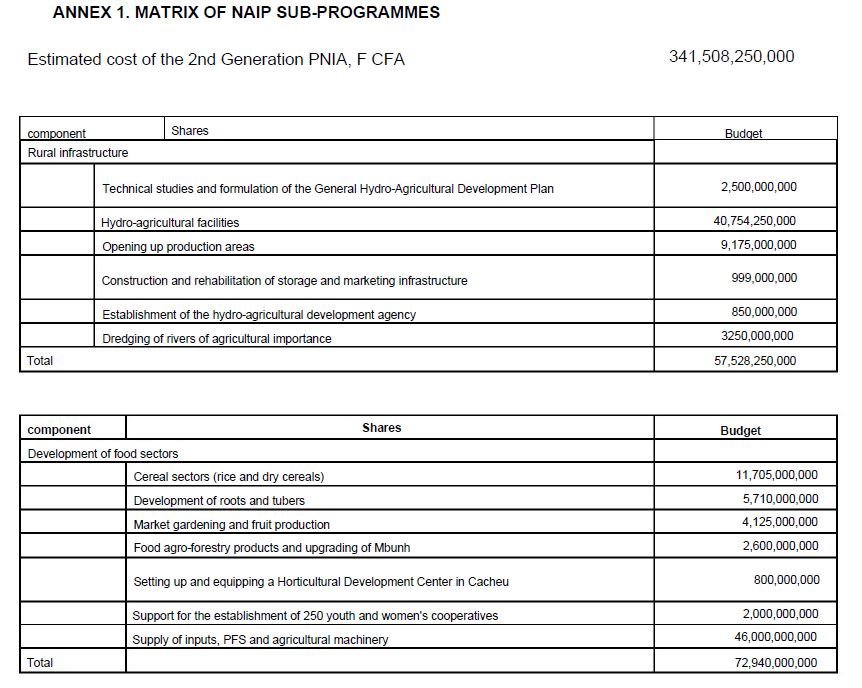
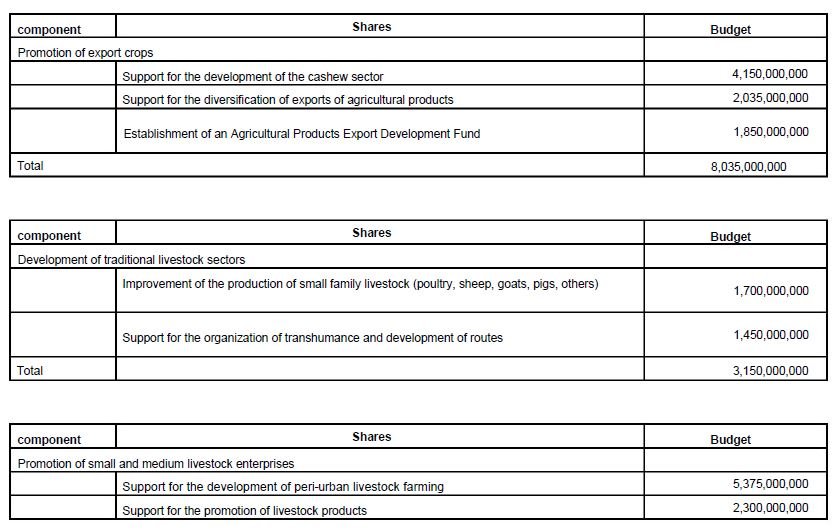
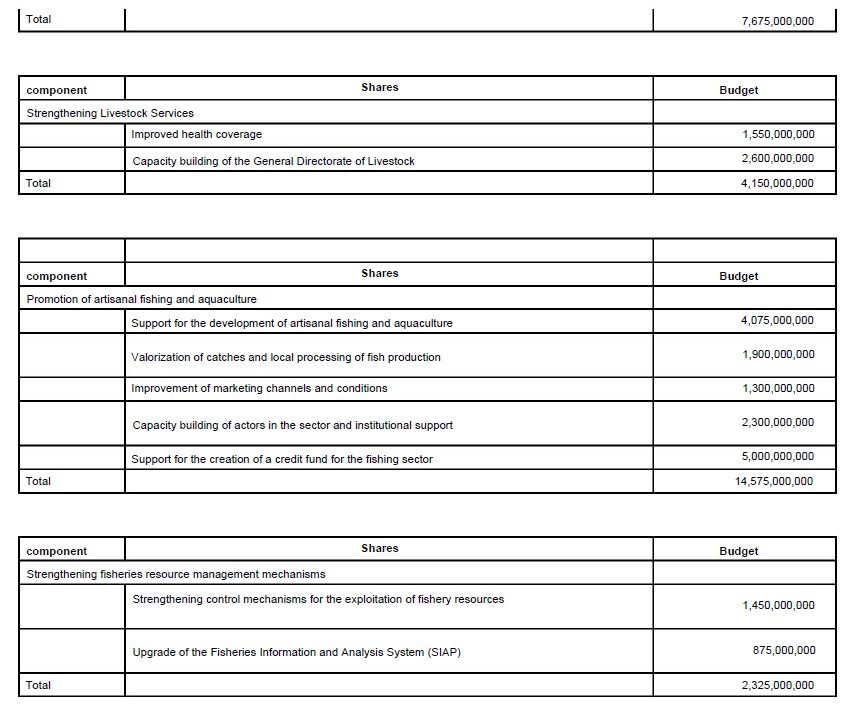
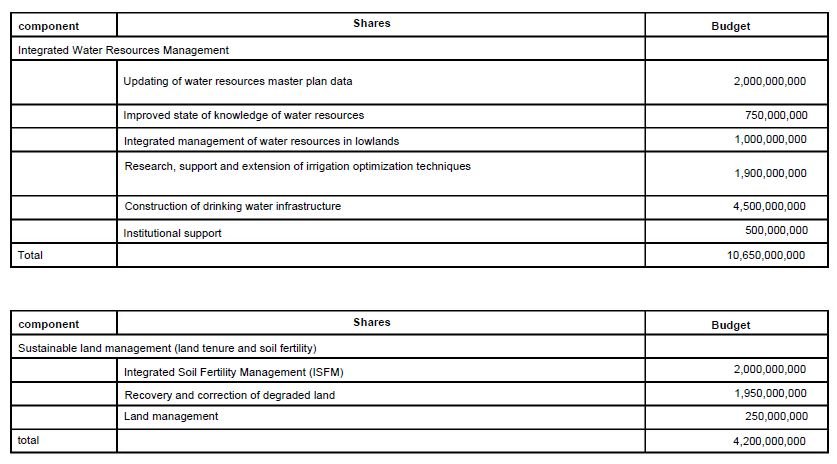
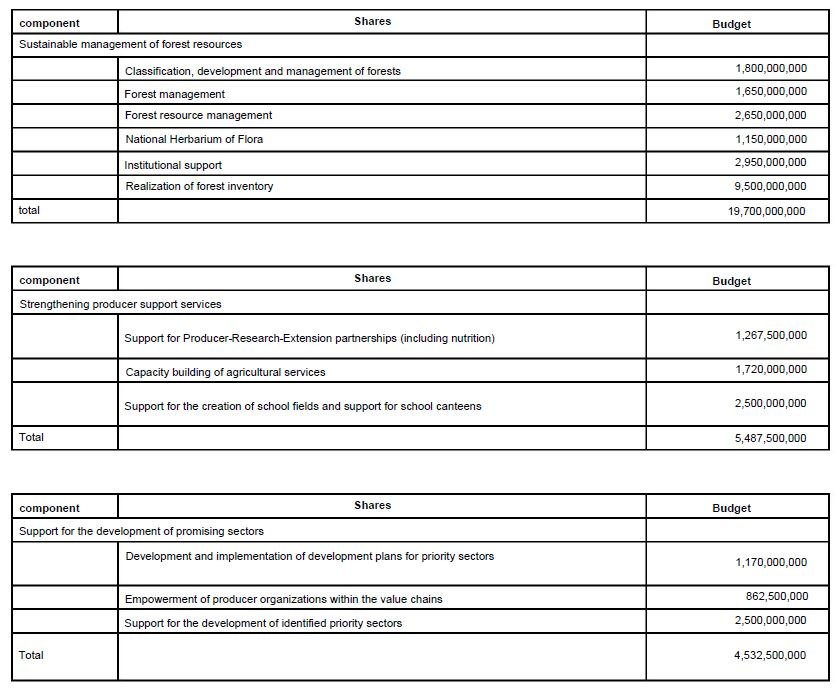
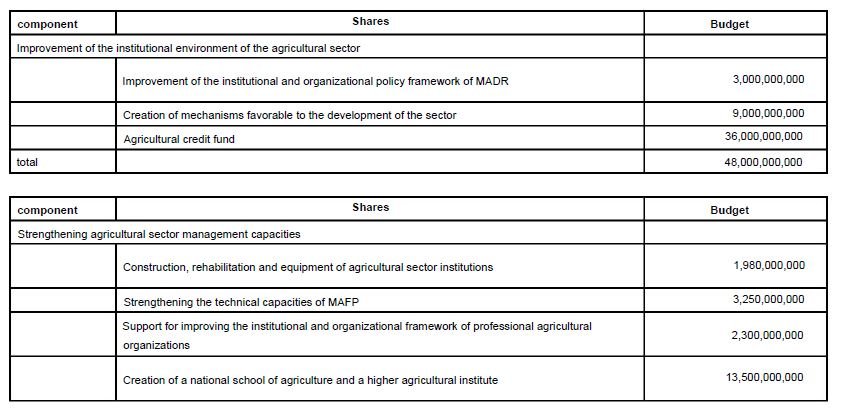
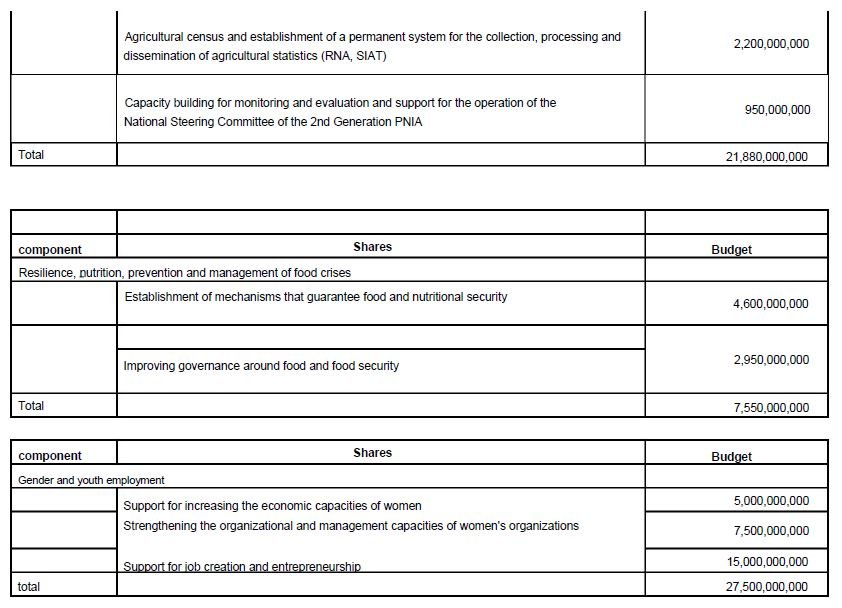
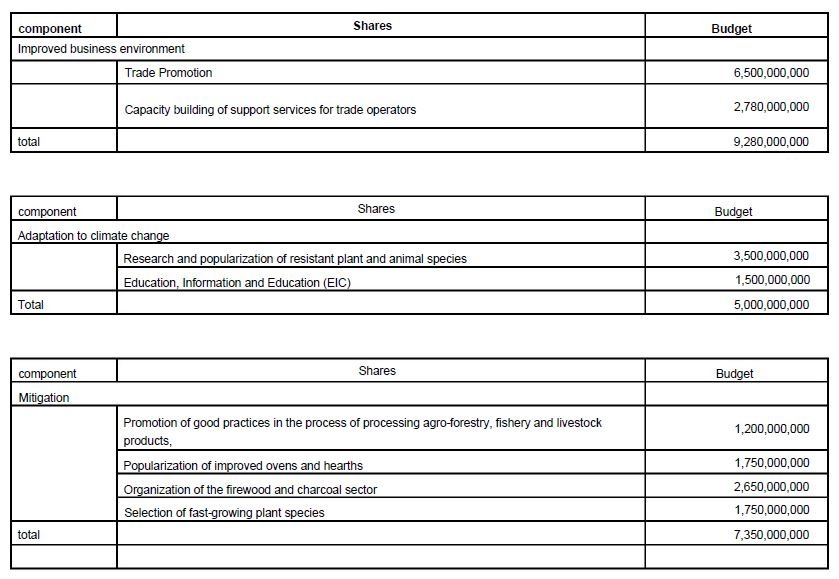
Acoording to the NAIP,
“The program is part of a long-term perspective which can be divided into three successive phases of five years each. In order to avoid breaks in the flow of funding and to cut off the dynamism generated during the first phase represented by this program, the Generation must go hand in hand with the phases concerned. Goals of each phase are the following:
PHASE 1 (2015 - 2020): this phase is characterized by the creation or rehabilitation of production support structures and infrastructures. A general plan for hydro-agricultural development, intensification and diversification of production, as well as support programs for producers in production factors, training, supervision, structuring of the rural world and strengthening of its organizations will have to be implemented. During the 2015-2020 period, the NAIP 2nd generation will therefore tackle first and foremost solving the problems of equipment for producers and the rural world, the upgrading of peasant organizations, the opening up of the main poles of production, in particular in terms of food production (which appears to be the branch agriculture that would contribute the most to agricultural GDP growth with a strong contribution to poverty reduction).
Simultaneously, it will be essential to ensure the institutional strengthening of the MAFP and the sectoral coordination mechanisms, so as to be able to guarantee efficient management of the efforts developed within the framework of the NAIP 2nd generation. At the end of this phase, we should thus have better organized and better structured farmers, breeders and fishermen. We should have strong agricultural organizations capable of influencing the formulation of policies and better defending their class interest.
PHASE 2 (2021-2025): during this phase, priorities will be devoted to the strengthening and consolidation of private initiatives and investments, the development of cooperatives and the consolidation of Farmer Organizations and Micro-Finance Institutions. In this phase, the conditions will be created to revitalize the rural economy by supporting the establishment of interprofessional mechanisms for the management of sectors, to effectively combat poverty and food insecurity. In this phase, we will tackle the implementation of major programs for the development of facilities and cereal production with particular emphasis on rice, the processing of agricultural and livestock products, conservation and marketing both agricultural and livestock products.
At the end of this phase, Guinea Bissau should have a more productive and more competitive agriculture, diversified and capable of generating the marketable surplus. At the end of this phase, the cereal deficit, especially rice, should be reduced by at least 50%.
PHASE 3 (2026-2030): this will be a phase focused on strengthening and consolidating integration in regional, sub-regional and international trade, which should aim to conquer new markets and facilitate trade. At the end of this phase, farmers' sources of income will be diversified thanks to the development of marketing, rural savings will have increased significantly and micro-finance institutions will be functional. At the end of this phase, we should see the development of export flows of food products (including rice) to supply certain regional markets with a deficit (urban in particular). At the end of this phase, Guinea-Bissau should achieve food self-sufficiency in terms of rice, as the staple food of its population.
Each phase must be accompanied by the production of a balance sheet and an update. of the NAIP.
The total cost of the 2nd Generation NAIP is estimated at around CFAF 341,508,250,000 billion ($531,318,479), of which 19.982 billion ($31 million) (5.85%) concerns projects in execution until 2020. Therefore, funding is sought. (nearly 321.526 billion CFA francs ($500 million, or 94.14%). In terms of productive investments, by 2030, the NAIP 2nd generation will affect all sectors in a cumulative way about 130,000 producers in the sub-sectors of plant production and animal production and 20,000 fishermen in terms of fish production. 250 agricultural cooperatives of young people and women will be created and 50 small and medium enterprises in the livestock sector and 20,000 youth jobs will be created.”
Now, in light of the ambitious program, let us return to the section of the report quoted in the beginning of this post:
“208. Agriculture, a key sector of the national economy, has failed to ensure food security or to create the conditions for improving the living conditions of rural populations, and even less to provide support for the development of others socioeconomic sectors. The weak results of the sector, in spite of the natural resources present, find their explanation in a series of factors such as: the low rate of investments made, the difficulties of access to means of production, credit and markets, the low technical level of holdings, etc.
209. The most important of these factors, which govern practically all the others, are however the inadequacy and limited effectiveness of public institutions and the extreme weakness of professional agricultural organizations which prevent the effective participation of farmers and the mobilization of potentialities. human and natural resources for development.
210. The Ministry of Agriculture, Livestock and Forestry (MAFP) is the Government body whose mission is to create favorable conditions for the development of agriculture with a view to achieving the main objectives of the National Plan of Agricultural Investment, thanks to the elaboration and implementation of adequate policies. The MAFP is however faced with multiple constraints, including: (i) weak institutional capacity to define priorities, coordinate and monitor public investment programs and the lack of qualified human resources. ii) lack of rigor in administrative management: deficiency in the administration of public assets, weak control, monitoring and evaluation mechanisms. Absence of a human resources policy (insufficiency of specialized executives), lack of financial incentives, and working conditions, etc. ; iii) an imbalance in the organization of the sector and weak intervention capacities in rural areas linked mainly to the concentration at the central level of trained or experienced managers; iv) a lack of real coordination capacity for harmonization of interventions; and (v) a lack of resources of all kinds and working methods.”
Sections 279. and 280. of the NAIP state:
“The quest for MDG1 in 2020 should lead to higher financing needs. These are estimated at 277 billion CFA francs (US $431,850,941) over the period 2010-2020, or an average of 25 billion (US $38,975,716) per year. The allocation of resources for financing investment and consumption expenditure would be CFAF 252 billion (US $392,875,2240 and CFAF 25 billion (US $38,975,716) respectively. Financing from the State's own resources would be around CFAF 27 billion (US $42,093,774). These internal resources would be allocated to investment and public consumption needs for CFAF 2 billion (US $3,118,057) and 25 billion (US $38,975,716) respectively. The financing “gap” to be sought is estimated at 250 billion CFA francs (US $389,757,167).
280. Mobilization of internal and external resources in pursuit of CAADP and MDG objectives in 2020. To achieve the average agricultural growth objective of 6%, the public expenditure required has been estimated at CFAF 133 billion. With a view to implementing the PDDA, the internal resources mobilized for this purpose are estimated at CFAF 13 billion over the period 2010-2015. As for external financing needs, they would therefore be around 120 billion CFA francs. In the quest to achieve the MDGs in 2020, the total cost of financing would be higher than in the case of the pursuit of the objectives of the PDDA since the expenditure would then be estimated at 277 billion CFA francs. The amount of financing from the State's own resources would be around CFAF 27 billion. As for external contributions, they would amount to 250 billion CFA francs. The projected allocation of resources to agriculture is summarized in Table 21:
Consider that 19.982 billion ($31 million) (5.85%) was obtained for projects in execution until 2020 and that “each phase must be accompanied by the production of a balance sheet and an update. of the NAIP.” Thus, the question must be asked -
HOW WAS THE $31 MILLION USED?
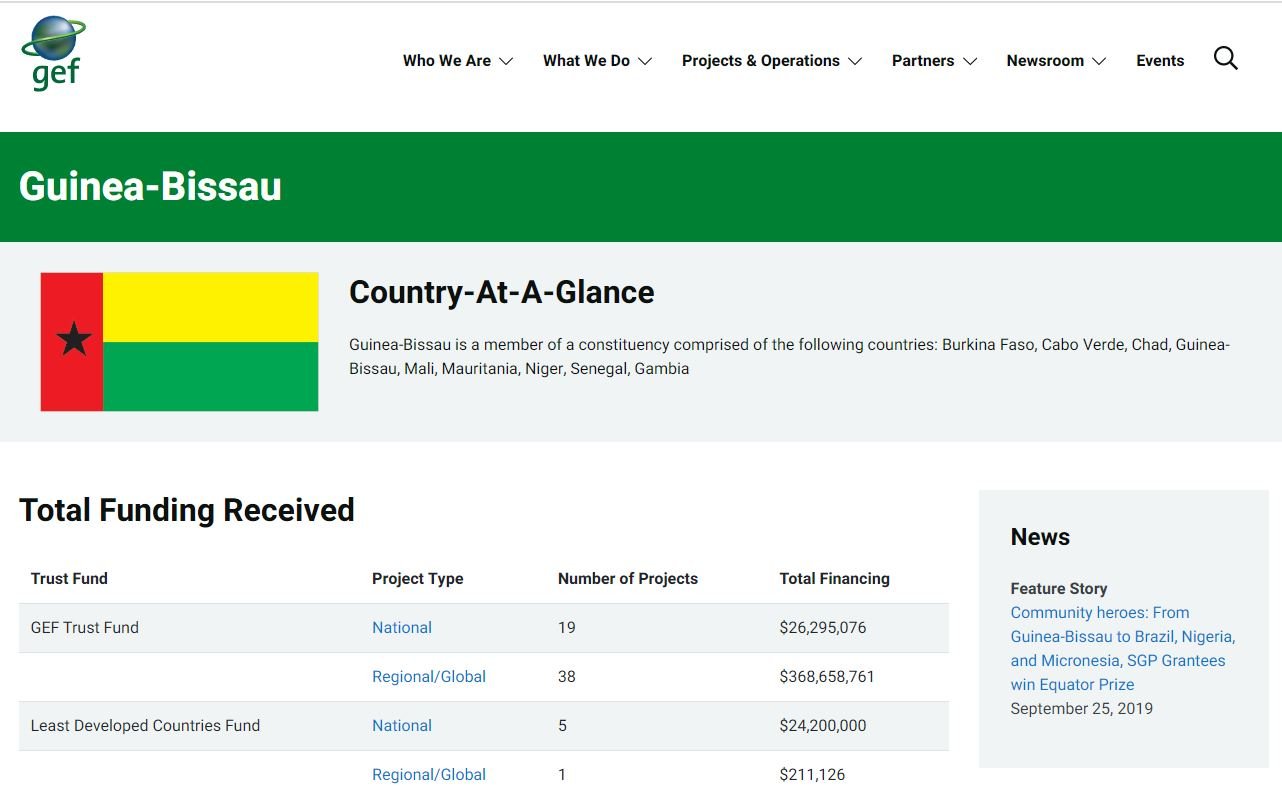
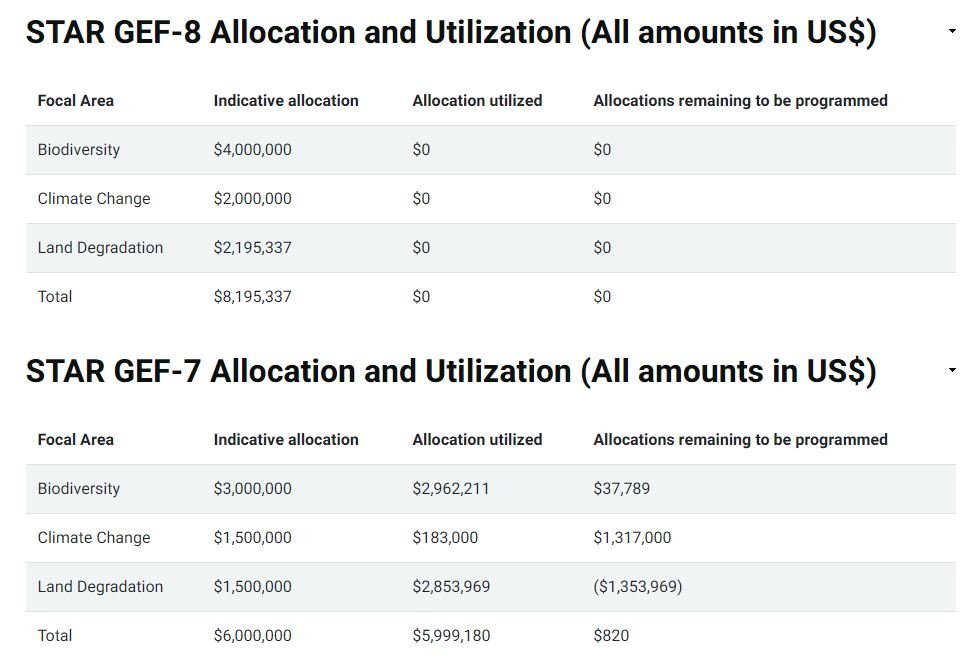
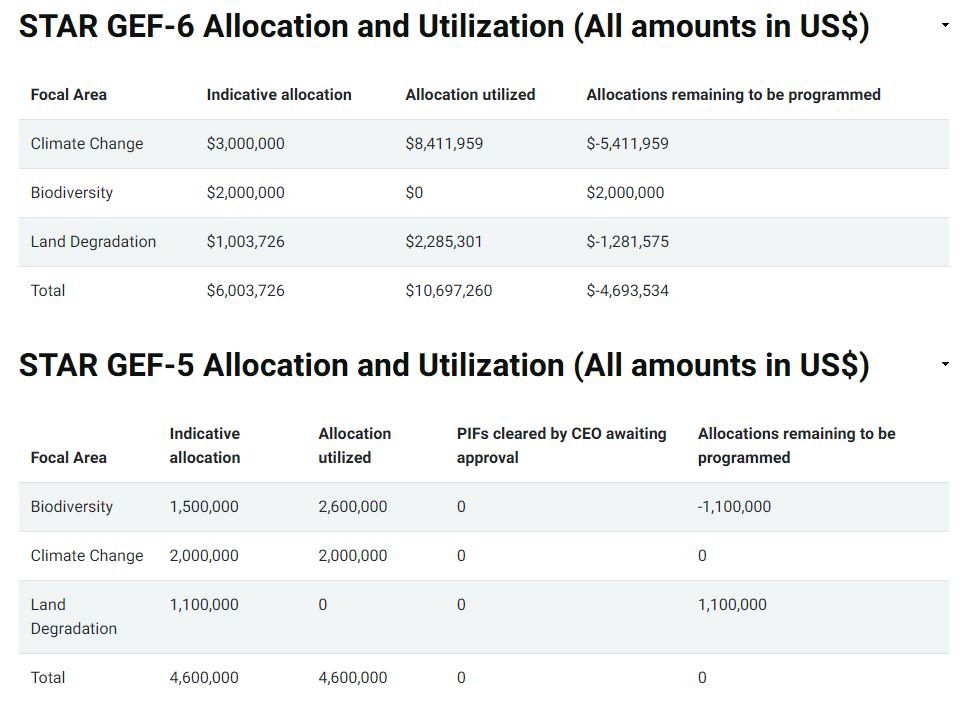

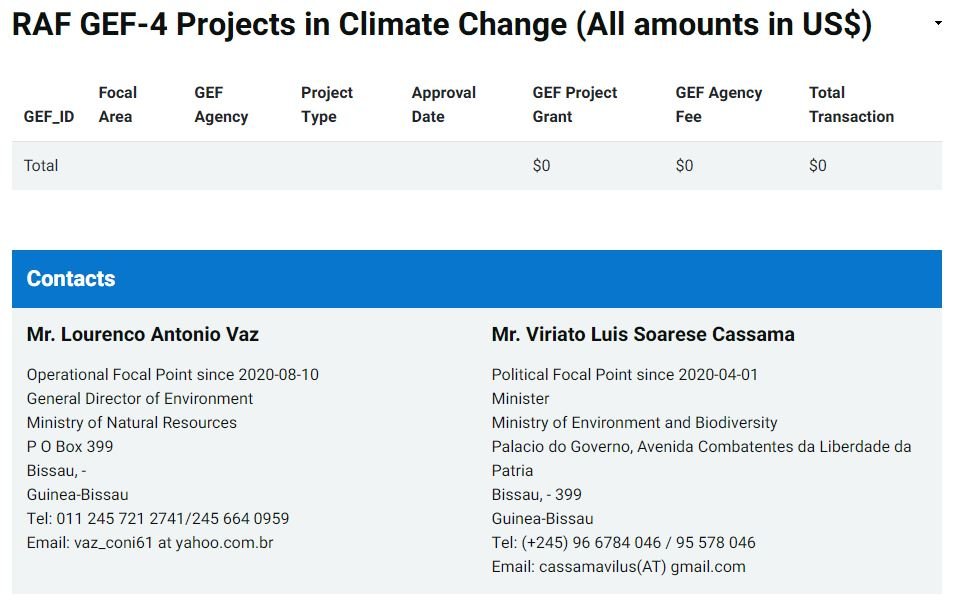
As an example, with respect to the cashew sector in Guinea Bissau, Section 107. of the NAIP states,
“The cashew sector experienced a boom from the 1980s and particularly the 90s, since exports increased from 57,870 tonnes in 1997, to 93,000 tonnes in 2004 and to 195,501 in 2016. Sixth largest producer in the world, Guinea Bissau is renowned for the quality of her cashew nuts, but she derives relatively little profit from them. Until now, in fact, it exports raw nuts, almost exclusively to India, which processes them, roasts them before re-exporting them to Europe and the United States. But currently, for lack of a minimum of organization and appropriate regulation, activities are carried out in a situation of relative “unfair competition and anarchy”.
SO WHERE DID THE MONEY REALLY GO? WHAT COMPANIES? WHAT WERE THE ACTUAL RESULTS? WHO BENEFITED?
Section 62. of the NAIP states,
“The active participation of all stakeholders at all levels (village associations, government officials, experts, NGOs, private sector, aid agencies, etc.) in the identification and design of projects should be encouraged.”
Section 230. states,
“GAPLA (The Agricultural Planing Cabinent within the Ministry of Agriculture, Forestry and Livestock (MAFP)) as the structure responsible for planning the development of the agricultural sector and the service that piloted the formulation of NAIP 2nd Generation must be a key service in its implementation. As such, it should be strengthened both in terms of personnel and equipment and should have an adequate operating budget. It will also be necessary to contribute, under its aegis, to setting up permanent mechanisms for the collection, processing and dissemination of agricultural statistics.
Section 238. states,
“Actions to improve the agricultural statistics mechanism should focus on the development of less expensive but representative market survey and monitoring methodologies, capable of providing quality information in a timely manner.”
Meanwhile, Section 292. states that a National Steering Committee (CNP), will be placed under the supervision of the Ministry of Agriculture and Rural Development (MAFP). Its creation as well as its mandate will be made by decree, signed by the Head of Government and will integrate the National Steering Committee, the General Directorates of Agriculture, Livestock, Forestry, and Fisheries, the Ministry of Trade, Environment, Infrastructure, Public Health, the General Directorates of Resources Water, Roads and Bridges, Customs, Public Treasury and Planning, as well as GAPLA which will provide the secretariat. Most importantly, section 293 states,
“The CNP will have the mandate to validate the documents relating to NAIP 2nd Generation and related projects, namely action plans and annual performance reports, strategic studies, etc. The CNP will meet at least twice a year when convened by the Minister in charge of Agriculture”;
Additionaly, section 294. states,
“At the regional level, a Regional Consultation Council (CRC) will be set up, in which, alongside the representatives of the decentralized services of the MAPF, the Regional Governors, the Prefects, the Religious Leaders and the representatives of grassroots associations and groups will participate. The CRC constitutes the basis for consolidating intervention requests, operational planning, the collection and organization of regional statistical data, and the monitoring and evaluation of actions. This structure serves as a forum for consultation and exchange on the effectiveness of the activities carried out under each sub-programme. The regional council will report directly to the National Steering Committee.”
Furthermore, section 301. stipulates the roles and responsibilities of cross-functional departments (DEA, DAF, DRH) As such, “they prepare, each according to its mandate, and at given intervals, for the attention of GAPLA and in the formats defined in the management manuals, consolidated national planning files, M&E and execution reports, financial management, training programs, opinions on strategic studies carried out on behalf of the ministry, statistical information, documents to be submitted to the steering committee, etc.” Specifically, section 302. states,
“The DRA (the Regional Directorates of Agriculture), under the authority of the Regional Director, is the anchoring structure of the Program at the regional level. It will be the geographical place of organization, animation, coordination of interventions, consolidation of the request for intervention, operational planning, collection and organization of regional statistical data, monitoring and evaluation of actions, control of standards and consistency with policies, development synergy between interventions, maintenance of dialogue with local partners and management of regional staff, development of regional budgets in accordance with the Finance Law in force and any framework notes, preparation of tender documents, monitoring of regional expenditure, preparation of regional financial statements, monitoring of the management of regional assets. Like the central technical departments, the DRAs prepare at given intervals, for the attention of the cross-functional central departments and according to the formats defined in the management manuals, the consolidated regional planning files, the M&E reports and for execution, financial management, etc. These files are received and used by the cross-functional departments in order to prepare the decision-making elements at the central level. The DRAs coordinate the CRCs.”
And finally, section 306. states,
“In general, it should be emphasized that MAPF structures are faced with problems of i) insufficient human resources, ii) technical skills and intervention capacities, and iii) obsolescence and /or lack of intervention standards and procedures. The success of the implementation of the Program will largely depend on the measures that will be taken to correct these shortcomings. These will be more marked at GAPLA, the DEA, DAF, DRA because of the mass of information that will converge at their level and the need for their quality processing in real time. In order to enable them to fully play their central role in the implementation of theNAIP 2nd Generation building their capacities in the areas of strategic planning, monitoring and evaluation, fiduciary management, human resources management, production and dissemination of sector statistics will be essential.”
Thus, in accordance with Article 34 of the Constitution of the Republic of Guinea Bissau (1984 revised 1996) which guarantees that “All have the right to information and legal protection in accordance with the law”, the Balanta B’urassa History & Genealogy Society in America calls on all citizens, and in particular, those groups and organizations concerned with agriculture and the future food security in Guinea Bissau, as part of the #savesolil movement in Guinea Bissau to
request, through the Regional Consultation Councils (CRCs) the finacnial statements prepared by the Regional Directorates of Agriculture (DRAs) and submitted to the National Steering Committee (CNP) through the GAPLA (The Agricultural Planing Cabinent within the Ministry of Agriculture, Forestry and Livestock (MAFP) as mandated by sections 62, 230, 238, 292, 293, 294, 301, 302 and 306 of the NAIP 2nd Generation.
Ministry of Agriculture and Rural Development
Current Minister: General Sandji Fati
Guinea Bissau ratified the United Nations Framework Convention on Climate Change (UNFCCC) on 27 October 1995 and ratified also the Kyoto Protocol on 18 November 2005 thus becoming a contracting Party to the Convention, committed to develop, update, publish the National Communications on Climate Change and other strategic documents on the same theme and participate in the Conferences of the Paties (COP).
He was born on August 8, 1956, in Bissau. Fighter for Homeland Freedom, leader of MADEM. He took the General Staff course in 1992/1993, in Portugal. Master's in military science (academy), in inter-branch (Navy, Air Force, Army and National Guard), in 1993/1994, at the Escola de Guerra in France. Parachutist officer in 1996, at the Air Transport School in the city of Pau (France). Graduated in Law from the Faculty of Law of Bissau, in 2003. He studied project management in the United States of America. Master's student in constitutional law at the Faculty of Law of Lisbon.He was Minister of National Education, he also held the portfolio of Defense and Freedom Fighters of the Homeland in the then executive of the government coalition and is appointed in the government of the presidential initiative to direct the portfolio of Agriculture.
PROJECTS
“Formulation of the National Priorities Exercises in Ambit of 5th GEF Restitution Final Report” - September, 2012 $30,000 from GEF. The support was conceded after the signature of agreement protocol between GEF and Guinea Bissau government.
“Strengthening of resilience and adaptability of the agricultural and water sectors to climate change in Guinea-Bissau” - GEF-supported project
“Supporting integrated climate change strategies” - UNDP’s signature programme, Guinea Bissau was supported with $200,000 and $10,000 co-funding from the government to support the development process of the Guinea-Bissau National Adaptation Programmes of Action (NAPAs). The NAPAs provide a process for Least Developed Countries (LDC) to identify priority activities that respond to their immediate needs to adapt to climate change, ultimately leading to the implementation of projects aimed at reducing the economic and social costs of climate change.
“Increased Resilience and Adaptation to Adverse Impacts of Climate Change in Guinea’s Vulnerable Coastal Zones” - Least Developed Country Fund (LDCF) November, 2009 $5,150,000. In relation to this, a new project “Strengthening the resilience of vulnerable coastal areas and communities to climate change in Guinea-Bissau” is expected to leverage a proposed USD 12 million Global Environment Facility Least Developed Country Fund Grant to develop the strong institutions and policies needed to improve risk management in coastal zones, protect investments in coastal infrastructure and diffuse new technologies to strengthen resilience within coastal communities.
“Scaling up climate-smart agriculture in east Guinea-Bissau” - Adaptation Fund for a five-year (2017-2022) project implemented by the Banque Ouest Africaine de Developement (West African Development Bank). $9,979,000. The project seeks to strengthen practices and capacities in climate-smart agriculture in the project region and at institutional level. Through the project’s activities, food security and livelihoods are expected to be strengthened at household level while simultaneously increasing capacities in climate risk management and adaptation planning at all levels of governance.
“Strengthening adaptive capacity & resilience to climate change in the agrarian & water sectors in Guinea-Bissau” - This UNDP-supported, GEF-LDCF funded project in Guinea Bissau was designed to transform the country’s policy responses to climate change from that of ‘reactive’ measures, towards achieving more ‘anticipatory’ and ‘deliberate’ policy responses. $4,000,000
“Strengthening climate information and early warning systems for climate resilient development and adaptation to climate change in Guinea-Bissau” This project will work to enhance the capacity of the National Hydro-Meteorological Services (NHMS) in Guinea-Bissau, ensure the effective use of weather and water information to make early warnings, mainstream climate change information into long-term development plans, and work toward ensuring the sustainability of investments in new climate services. $6,000,000 from the Global Environment Facility’s Least Developed Countries Fund (GEF-LDCF).
TOTAL IDENTIFIED FUNDING: $37,369,000
The National Food Security Program, which constitutes a separate and already approved document….




DEMOCRAT NEWSPAPER 04/19/2023 - “The National Cell for the Processing of Financial Information (CENTIF-GB) revealed on Tuesday, April 18, 2023, that risk assessment data on the processes that were reviewed, both at the Public Ministry and at the Judiciary Police, indicate that Guinea-Bissau Bissau is losing a lot and that 85 billion and 853 million of State assets could be in the hands of others.
The revelations were made by the president of CENTIF, Justino Sá, at the opening of the three days of training (18, 19 and 20) on matters of financial investigation, accusations and convictions for crimes of money laundering and financing of terrorism, held at the National School of Administration (ENA), aimed at actors in the criminal chain.
Justino Sá explained that the seminar was held as part of the implementation of the recommendations of the mutual risk assessment report that Guinea-Bissau was subject to in 2020 and 2021, arguing that the CENTIF should equip the law enforcement staff with tools that allow them to fulfill and fully perform its functions.
Justino Sá asked the Attorney General of the Republic to transform the office for the fight against corruption and economic rights and adopt the principle of mobility of magistrates, being a very sensitive office, having defended the specialization of magistrates so that Guinea-Bissau be more sensitive to the phenomenon of the fight against corruption.
According to Justino Sá, the amounts referred to are those found in the processes that were investigated from 2013 to 2018, revealing that the country could have lost 100 billion CFA francs.
Faced with this situation, Justino warned magistrates that they have a very important role to play in the fight against money laundering and terrorist financing.
He said that this situation should not only be a concern for the CENTIF, but also a national concern, especially for judges who have the mission to work for the credibility of justice.
The president of the CENTIF stressed that one of the shortcomings that the cell pointed out in the mutual evaluation was effectiveness, because “there was no conviction for the crime of money laundering and financing of terrorism in Guinea-Bissau, as well as the confiscation of assets of any corrupt people or traffickers.
In turn, the Attorney General of the Republic, Edmundo Mendes, said he hoped that the seminar would provide participants with the necessary tools to detect, investigate, prosecute and effectively condemn the actors of organized crime.”
By: Carolina Djemé





